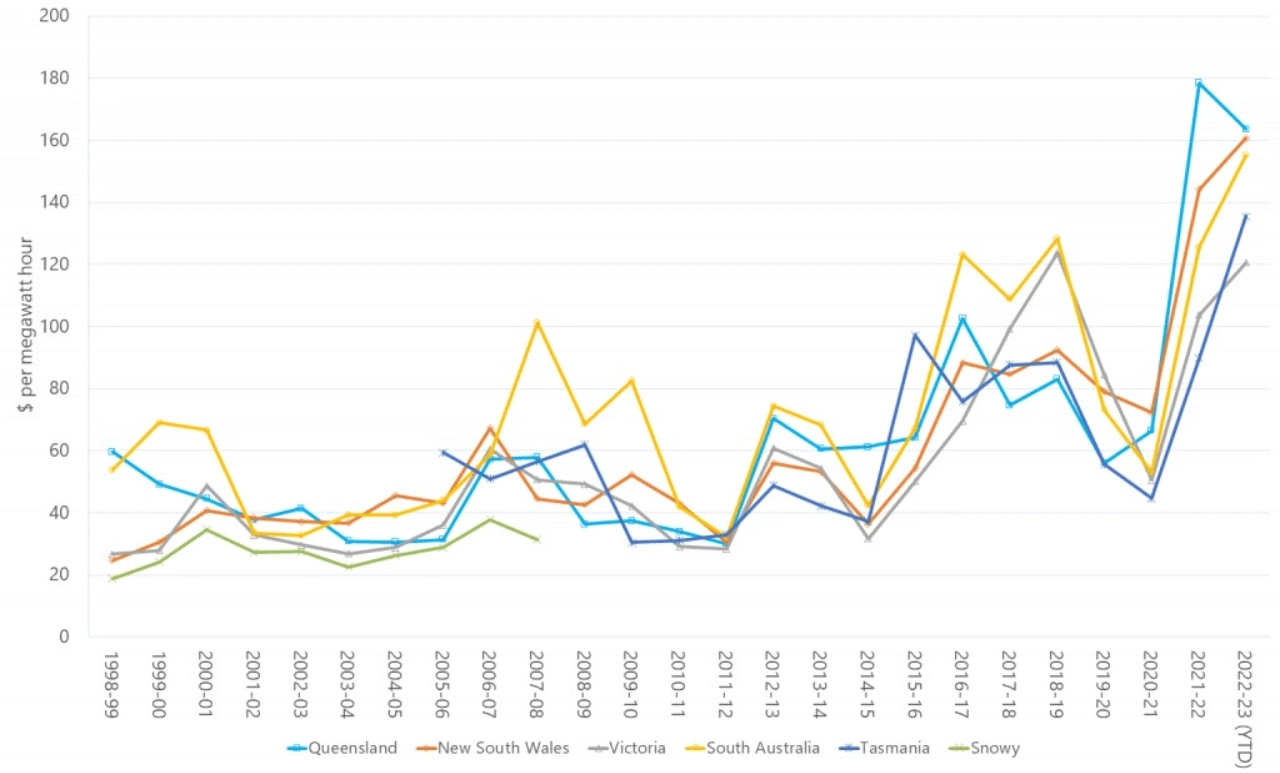SOLAR & FEED-IN VALUES
SOLAR & FEED-IN VALUES
Feed-In values change with time-of-day
The abundance of solar in the grid means generation and feed-in has less value at midday, and is more valuable after 4pm.
How can power prices increase when feed-in seems to be reducing?
Electricity prices, like most commodities, are a consequence of supply and demand. There is commonly an abundance of solar pushing prices down in the solar hours while the overall price of power is increasing. We see this in the annual weighted average 30 minute price of wholesale power chart from AER (Australian Energy Regulator). https://www.aer.gov.au/wholesale-markets/wholesale-statistics/annual-volume-weighted-average-30-minute-prices-regions

There is no doubt that, overall, across the country price increases show no signs of abating. It’s just that supply and demand for power are not evenly matched across the day. As for solar, you could say that Australia has overachieved its goal when it comes to household solar energy. Homeowners collecting the sun’s abundant renewable energy and using it to power their appliances is an amazing thing that we now take for granted.
Households feeding their excess energy into the grid is also a tremendous thing – but only to a point.
It’s a great thing when other users need that abundant energy, but not such a good thing when nobody is using it. After all, the grid was never designed to cope with holding on to excess energy until it’s needed.
So, in the middle of the day when the sun is shining demand for energy is low, there’s simply too much solar energy available. Nobody wants or needs it and there aren’t enough people with the capacity to store it for use later, when the demand picks up.
| VIC Regulated Feed-in Tariff | Rates FY24-25 (Excl. GST) |
Rates FY25-26 (Excl. GST) |
| Peak (4pm – 9pm) everyday | $0.084 per kWh | $0.000 per kWh |
| Shoulder (9pm – 10am) & (2pm-4pm) everyday | $0.041 per kWh | $0.000 per kWh |
| Off-Peak (10am-2pm) everyday | $0.021 per kWh | $0.000 per kWh |
If eligible, you’ll receive any applicable regulated Feed-In Tariff. Where this doesn’t apply, GloBird may offer voluntary feed-in rate/s. Feed-in rates are subject to change, and we’ll notify you before any updates take effect. For more information, visit https://www.globirdenergy.com.au/legal/
When will feed-in rates increase?
The value of generation or “feed-in” rates (not necessarily solar) has increased, but generation value is generally higher outside of the solar period. Back in the day (about 10 years ago), demand for energy from the grid used to be relatively flat across the day.
As more and more rooftop solar came into the mix, the demand on the grid in daylight hours gradually decreased, however, once the sun went down, the peak became a real spike.
Year by year, the divergence between daytime demand and evening demand has increased, as illustrated in this diagram (which borrows modelling from the Californian ‘Duck Curve’ chart).
Essentially, the duck curve shows the impact of the abundant solar available in the middle of the day. Low prices when the sun is shining (when most people are at work, school etc), with a spike coming when the solar starts to reduce and the demand increases.
There are two things that can help make that duck less ducky: more people using energy in the middle of the day and increased storage capacity to keep the excess solar energy out of the grid until there is demand for it.
GloBird Energy has addressed the first thing with our Free Lunch. It’s our plan to incentivise customers to run their washing machines, dryers, dishwashers, and any other “non-time-sensitive” appliances when they’re most likely being powered by renewable energy, by making electricity 100% FREE between midday and 2pm.
That time shifting of usage means an equivalent amount of electricity generated from non-renewable sources isn’t being ‘demanded’ after the sun goes down. The second part of the equation relies on a greater take-up of battery storage, which has started happening and other non-solar forms of generation.
SunWiz reports that about 15% of new solar PV installations in 2022 were combined with home storage, an increase from around 10% in 2021.
An estimated 47,100 storage systems were installed last year, equivalent to about 589MWh capacity, up over 50% on the 2021 figure of 333MWh. That brings us to around 180,000 cumulative installations with about 1,920MWh of capacity installed since 2015.
South Australian, Victorian, and ACT residents have access to subsidy programs.
Why has my feed-in structure changed to “time-of-use”?
To encourage those who have the capacity to feed-in their excess energy at times of peak demand to help us flatten the “Duck Curve”, we’re introducing time-of-use feed-in tariffs.
By having three different rates, depending on the time of day and its corresponding demand level, we will reward customers who feed-in at times when their energy is needed most and when it supports the grid.
The reality is that it no longer makes sense to offer a single flat feed-in rate, because that could only be extremely low, and the incentive would become negligible. There would be no access to the additional value of energy at peak times.
What can I do?
GloBird want to encourage as many customers as possible to feed-in when their excess energy is most needed – which, to a large degree, also means encouraging more households to install battery storage – we’re helping move Australia’s renewable energy transition to the next phase.
Admittedly, there will be some solar energy customers who aren’t in a position to feed-in at the times they’ll receive the better rate, however, the important thing is that we are incentivising vital changes to what has become an unsustainable model.